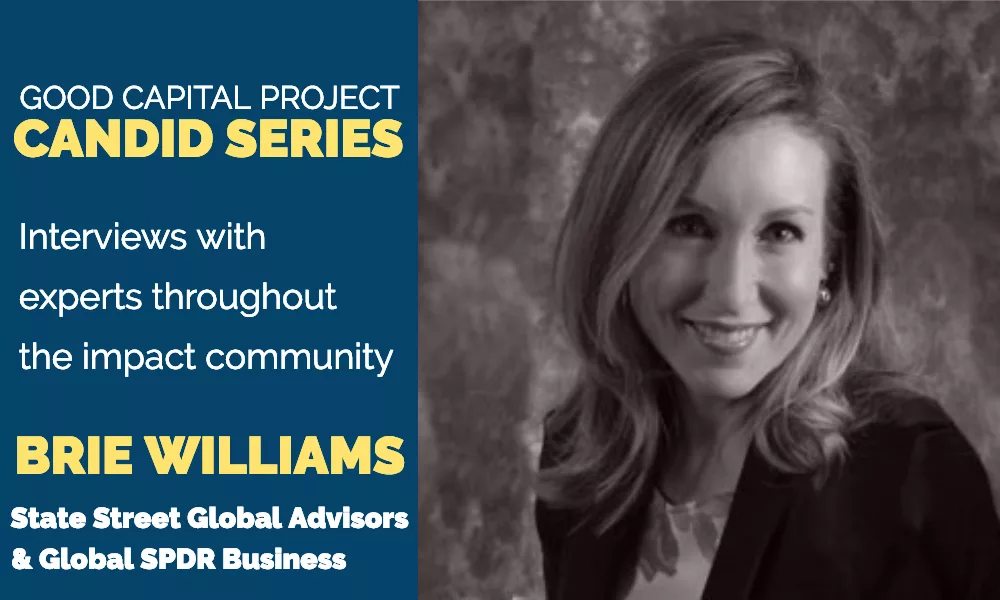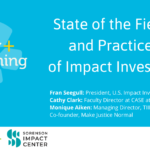
Brie is a Vice President of State Street Global Advisors and Head of Practice Management for the Global SPDR Business. She manages a team dedicated to the evolving needs of wealth management firms and financial advisors; developing business-specific insights to facilitate growth and efficiency beyond asset management.
Good Capital Project: Tell us about your personal journey to impact and your work with wealth managers and investment advisors.
Brie Williams: My path to the finance industry was not direct. In college, I was working towards a career in broadcast journalism when I was offered an opportunity to work in advertising. About 12 years later, the creative whirlwind took a new turn when I was bitten by the wealth management bug – an asset manager took a chance on me at a turning point in their history. Now, I’m with State Street Global Advisors (SSGA) where I established a business development and consultative resource for the Global SPDR intermediary business. I currently lead the Practice Management team and find our work to be extraordinarily fulfilling with many opportunities to embrace a new challenge.
I have the flexibility to work with a range of clients and colleagues across a broad scope of geographies and industries. My role revolves around relationship-based teamwork since engagement drivers help us understand our impact and the perception of value. I love how this business gives an immediate feedback loop, which allows us to continuously test our views, and the opportunity to problem-solve in real time.
GCP: As one of the largest asset managers in the world, can you tell us about a few trends State Street Global Advisors has seen in the ESG investing landscape?
BW: The field of environmental, social, and governance (ESG) investing has undergone rapid changes in recent years. Let’s focus on three specific strategies: the integration of ESG strategies, data sources supporting ESG data, and the need for enhanced reporting. These trends were also noted as top priorities on GCP’s Total Impact conference series agenda.
First, we are seeing investors move away from purely exclusionary and towards integrated ESG strategies; a key theme discussed at many of the Total Impact Conference sessions. For decades, we’ve seen asset owners use exclusionary strategies to keep securities that do not align with their values out of their portfolio. Increasingly, we are seeing investors embrace ESG investing due to the value it offers to long-term investors. Investors are no longer looking at ESG factors as a separate consideration. Instead, they see it as complementary data to be integrated into traditional financial information. It’s important to recognize that exclusion and integration are not mutually exclusive approaches to ESG investing. Exclusionary screens are often an overlay to an integrated approach, which allows investors to build ESG portfolios that closely align with their objectives.
The second trend revolves around investment strategies increasingly powered by multiple sources of ESG data. Historically, we’ve seen investors rely on a single source of ESG data to inform their investment processes, which typically is provided by a third party who is applying their own proprietary methods. Research from State Street Global Advisors shows there is often a low correlation between how different data providers score the same universe of companies. In response, we are increasingly seeing investors embracing investment solutions that are based on multiple providers.
The third trend is the growing demand to understand ESG performance of the portfolio against desired objectives, driving the need for enhanced reporting. Investors are looking at ESG as a value-based dimension in their portfolio. Increasingly, they want to understand ESG performance in the same way as they would any other traditional financial measure. Demand from beneficiaries and stakeholders for greater insight into the ESG profile of their investments leads to greater interest in robust ESG reporting along dimensions such as carbon intensity, controversy exposure, and overall ESG profile.
GCP: Considering the latest trends, how are wealth managers responding to the acceleration of ESG and impact investing?
BW: An integrated ESG approach provides opportunities for sustainability over time. The opportunity to address sustainability factors, alongside conventional securities analysis continues to show this sector is beyond being a fad. Data and analytics are evolving. Adoption of ESG investing and asset growth has accelerated. Institutional and individual investor demand is prompting more uniformity of metrics, increased availability and transparency of data, and better methods to address fund survivorship bias (which can distort comparisons of investment options). More work is needed in creating a consistent framework for companies, index providers and asset managers.
GCP: What are some of the sectors within ESG and impact that are getting most traction from your constituents at SSGA?
BW: Threat of climate change and the depletion of resources has grown. Climate solutions will evolve to include adaptations alongside mitigation. For asset owners who seek to invest in a way that is aware of and responsive to climate change, solutions in the marketplace have traditionally focused on mitigation: reducing the effects of climate change on a portfolio by, for example, reducing exposure to greenhouse gases and increasing exposure to green energy companies. As extreme weather events become more frequent and the economic impacts of climate change more widely understood, investors will require companies to disclose how they are adapting business strategies to accommodate the impacts of climate change. Investors on the leading edge of climate investing will seek to enhance their climate investment from pure mitigation strategies to those that align to a mitigation and adaptation investment thesis.
One of the fast-growing parts of sustainable investing is gender lens investing; investing with an aim to earn financial returns and address gender disparities. Jackie Vanderbrug, author of Gender Lens Investing: Uncovering Opportunities for Growth, Returns, and Impact, looked at the education of women, employment of women, and women’s entrepreneurship as thematic drivers. Her work presents a dynamic, global picture of women’s economic roles, demonstrates the relevance of using a gender lens in investment analysis and portfolio construction, and shows us how investors can apply a gender lens in their own evaluation process. There’s some confusion around what constitutes as gender lens investing. I think Criterion Institute provides an excellent summation of the gender lenses through which investors can determine how to invest their capital.
There are three distinct, but interconnected areas of opportunity relevant to the investing community. One is increasing access to capital for women, for example access to equity, loans, and financial training. The second area where investors can determine how to invest their capital is in workplace equity, such as increasing the number of women on boards, senior leadership positions, and altering the gender landscape at the top. The third area where investors can determine how to invest their capital is in products and services that benefit women. This can be a wide range of business models and products ranging from reproductive maternal health innovations to day care services to money management training. In general, investments revealed through this lens respond to a need that is particularly unique to female consumers.
Millennials and women are individual investor segments that are ahead of the curve. They are taking a more inclusive strategic approach and expecting us, as industry professionals, to help them have greater impact in how they invest, distinctly combining performance with purpose. Looking at the millennial demographic, US Trusts Wealth and Worth survey reports 67% of millennials placing higher value on making an impact and they are investing to pursue values over the long term. Looking at our female investors, Morgan Stanley’s Sustainable Signals perspective reports they are nearly twice as likely as male investors to consider both rate of return and positive impact when making an investment. So when we think about our next best opportunity to grow in ESG, these two individual client segments are worth a closer look, if you’re not already engaging them.
GCP: You have frequently talked and written about the importance of committing to investors and their unique requirements. Financially empowering women is a key philosophy underpinning our work at GCP; how does working at State Street Global Advisors support your interests?
BW: State Street Global Advisors is well known for our call to action to improve gender diversity at the board level. Our approach to asset stewardship is designed to have an impact, proactively. We are in a unique position at SSGA to use our voice and our vote. Given the influence we have as the third largest asset manager in the world, we take our responsibility as a fiduciary seriously and consider ourselves stewards of the assets we mange on behalf of our clients. The time is now for all companies to recognize that gender diversity is essential to the bottom line. It’s imperative to long time corporate performance, as well as economic prosperity. We engage on this issue as stewards of the assets we manage in two ways – we seek to drive diversity through dialogues and engagements, and if necessary, we will use our proxy voting power to effect change just like we would with regards to any other long-term risks to our clients’ portfolios.
From what we see at State Street Global Advisors, the needle is definitely moving. We placed Fearless Girl in 2017 on the eve of National Women’s Day, and during that proxy season we voted against 512 companies for failing to take action regarding their board gender diversity. Although the board selection process can be rather lengthy, we have seen 423 companies add women to their board. We also have pledges to take action to improve gender diversity from asset managers and asset owners, whose power represents $13 trillion in shareholder assets. There’s a quote from Marian Wright Edelman that always sticks with me, which is “you can’t be what you can’t see.” I believe our Fearless Girl is a symbol of women in leadership for women today and the progress that’s been made over the years, as well as the women who will follow in their footsteps.



